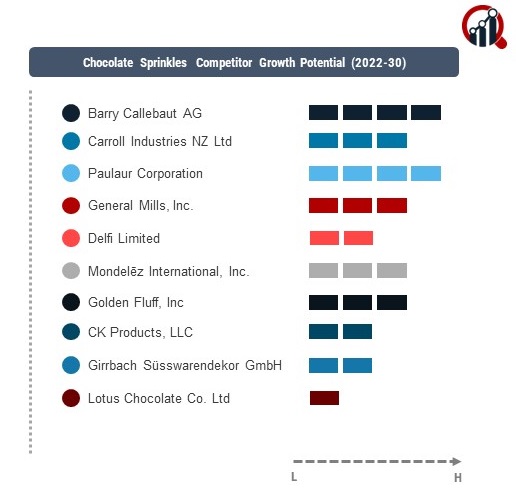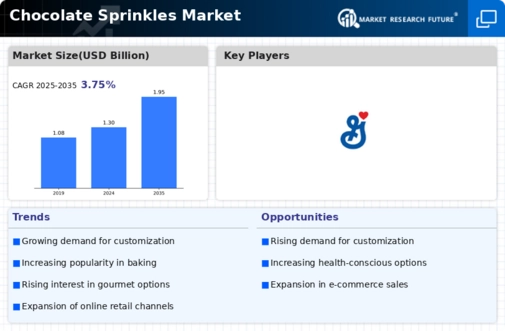Top Industry Leaders in the Chocolate Sprinkles Market
 The Competitive Landscape of the Chocolate Sprinkles Market is marked by a combination of well-established brands and emerging players, contributing to the global demand for this popular confectionery item. As of 2023, key players in the market have strategically positioned themselves to capitalize on the enduring appeal of chocolate sprinkles in various food applications.
The Competitive Landscape of the Chocolate Sprinkles Market is marked by a combination of well-established brands and emerging players, contributing to the global demand for this popular confectionery item. As of 2023, key players in the market have strategically positioned themselves to capitalize on the enduring appeal of chocolate sprinkles in various food applications.
Key Players:
Barry Callebaut AG (Switzerland)
Carroll Industries NZ Ltd. (New Zealand)
Paulaur Corporation (U.S.)
General Mills, Inc. (U.S.)
Delfi Limited (Singapore)
Mondelēz International, Inc. (U.S.)
Golden Fluff, Inc. (U.S.)
CK Products, LLC (U.S.)
Girrbach Süsswarendekor GmbH (U.S.)
Lotus Chocolate Co. Ltd. (India)
Strategies Adopted:
The Chocolate Sprinkles Market revolve around product diversification, marketing efforts, and strategic partnerships. Product diversification strategies involve developing new variants of chocolate sprinkles, including different flavors, shapes, and sizes, to cater to evolving consumer preferences. Marketing efforts focus on brand visibility, emphasizing the quality and versatility of chocolate sprinkles for use in baking, desserts, and confections. Strategic partnerships with retailers and food manufacturers enhance the availability and accessibility of chocolate sprinkles to consumers.
Market Share Analysis:
Market share analysis in the Chocolate Sprinkles Market is influenced by factors such as brand recognition, product quality, pricing, and distribution efficiency. Companies with strong brand equity and a reputation for producing high-quality chocolate sprinkles often enjoy a competitive advantage. The taste, texture, and appearance of chocolate sprinkles are critical factors that influence consumer preferences, contributing to market share. Competitive pricing strategies that balance affordability with quality are essential for attracting a broad customer base. Efficient distribution networks, collaborations with supermarkets, and partnerships with food service providers contribute significantly to a company's competitive position.
New & Emerging Companies:
The Chocolate Sprinkles Market contribute to the competitive landscape by exploring innovative formulations, organic and natural ingredients, and unique packaging designs. Start-ups such as Fancy Sprinkles and The Sprinkle Sisters have entered the market, focusing on premium and artisanal chocolate sprinkle options. While these companies may initially have smaller market shares compared to industry giants, their emphasis on creativity, quality ingredients, and niche markets adds diversity and appeal to the market.
Industry Trends:
Industry trends provide insights into ongoing developments within the Chocolate Sprinkles Market. A notable trend in 2023 is the increased interest in clean-label and natural chocolate sprinkles. Key players are investing in sourcing high-quality cocoa, avoiding artificial colors and flavors, and communicating transparently about ingredient origins to meet the growing consumer demand for natural and wholesome products. Additionally, investments in digital marketing and social media campaigns highlight the versatility of chocolate sprinkles and encourage consumer engagement.
Competitive Scenario:
The Chocolate Sprinkles Market remains dynamic, with companies adopting diverse strategies to gain a competitive edge. There is a notable emphasis on e-commerce and online sales channels, with companies leveraging digital platforms to reach consumers directly and offer a wide range of chocolate sprinkle products. Additionally, companies are exploring opportunities for collaborations with food bloggers, influencers, and baking enthusiasts to enhance brand visibility and access niche markets.
Recent Development
The Chocolate Sprinkles Market is the growing emphasis on sustainability. Key players are actively exploring ways to reduce environmental impact, such as eco-friendly packaging options and responsibly sourced cocoa. This development reflects the industry's responsiveness to the increasing consumer awareness of sustainability issues and the demand for eco-conscious products.

- Beta
Beta feature









